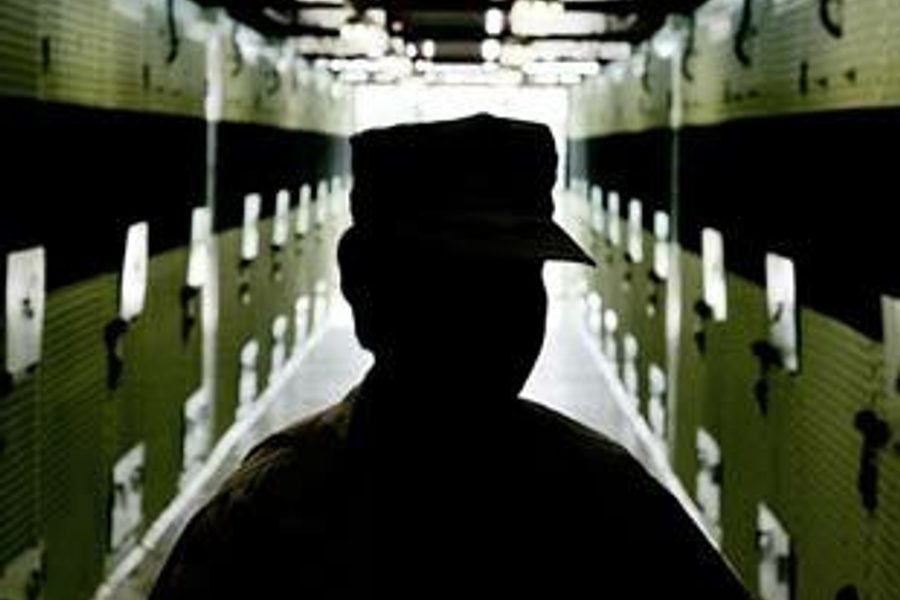
His psychiatrists call it “Groundhog Day.”
José Padilla – the once-renowned “dirty bomber” who is now little more than a dim light in the government’s galaxy of desperadoes – has spent almost five years in solitary confinement. Whenever his lawyers attempt to discuss his case with him, he has the same response, begging them over and over again not to. When they try, his face seizes in tics and his body contorts uncontrollably.
“Mr. Padilla may be suffering from some form of brain injury,” writes a forensic psychiatrist who evaluated him for his lawyers. His story illuminates what has happened to many prisoners of America’s war on terror.
In addition to being tormented psychologically, Padilla and other Guantánamo detainees say the U.S. military has drugged them against their will. Each new disclosure of U.S. treatment of detainees hints at a continuing fascination in the intelligence community with developing and employing interrogation techniques that arise from a long and spotty history – techniques intelligence research says cannot be depended on to extract reliable information.
Accusations of drugging
In These Times has learned that several other detainees have joined Padilla in claiming they were involuntarily drugged.
Adil Al Nusairi, a 33-year-old former Saudi police officer, says he was imprisoned by the Taliban while traveling to Pakistan for eye surgery, before being sold to U.S. forces for a bounty by Pakistani police. Several times during his four-year incarceration at Guantánamo, Nusairi claims he was injected with an unknown substance, according to his lawyer, Anant Raut.
One time, groggy and disoriented after spending half a day in a freezing cell, he says he was interrogated for hours, his captors demanding over and over that he admit he was part of al-Qaeda.
“OK, I’ll admit it, if you’ll let me sleep,” he said, according to his lawyer’s notes. Sent back to his cell, Al Nusairi tried to read the Koran and couldn’t. He became so weak he could barely lift his arms. His vision blurred and he began to drool uncontrollably onto himself.
Despite facing allegations similar to many other detainees, Al Nusairi was released from the camp last May along with 14 of his countrymen in a series of incremental releases detainee lawyers find arbitrary. The men were held briefly by the Saudi government, but are now free – although they have been instructed not to speak about their experience.
Two other Guantánamo detainees say they’ve found drugs powdered or half-dissolved in their food and drink. Kristine Huskey, now at American University’s International Human Rights Law Clinic, represented one of the men, Fawzi Al Odah, a Kuwaiti who is still being held captive. Lawyers for the other detainee who has reported finding drugs in his meals have requested anonymity to protect their client from potential repercussions.
The effects detainees report are consistent: Dizziness and disorientation, lethargy and “clouded” thinking. Lawyers say the reports are credible because they were volunteered by the detainees, were not produced in response to government demands or accusations, and are detailed, discrete events.
Because of the obstacles repeatedly put in front of counsel, lawyers for the detainees have difficulty accessing medical records. Padilla, however, boasts something no Guantánamo detainee can: A U.S. passport. Because he is a U.S. citizen, his lawyers have been able to investigate his detention more closely than any Guantánamo prisoner. Finding out what has been done to this very broken man could breach the walls erected by the Bush administration around the medical and psychological treatment of the 14,000 prisoners that the Pentagon says are currently being held in Iraq, Afghanistan and Guantánamo.
Becoming an enemy combatant
In May 2002, eight months after the 9/11 attacks, Padilla was arrested at Chicago’s O’Hare International Airport, accused of plotting to explode a crude radioactive bomb. He spent three and a half years at the Charleston Naval Brig in South Carolina as an “enemy combatant.” In December 2005, when an imminent Supreme Court deadline could have forced a precedent-setting review of his military imprisonment, the Bush administration changed his status from “enemy combatant” to criminal defendant. Pending a review of his mental competency, he now faces a civilian jury in Miami on federal charges of conspiring to participate in and aid “violent jihad” in Bosnia and Chechnya in the late ’90s. Robert Chesney, who specializes in national security law at Wake Forest University, has compared the prosecution’s tactics to charging Al Capone with tax evasion.
The government now pins responsibility for the “dirty bomb” plot on Binyam Mohamed, a detainee at Guantánamo and one of three prisoners who made statements under duress connecting Padilla to al-Qaeda’s leadership. After being captured in Pakistan, Mohamed was rendered to Morocco at the behest of the United States. Moroccan jailors elicited the information about Padilla at the tip of a razor blade, sunk repeatedly into Mohamed’s genitals, according to his attorney, Clive Stafford Smith.
Mohamed’s case may one day be heard in the new $125 million Guantánamo tribunal building, future home of the administration’s quasi-courts. It’s a legal environment plastic enough to permit hearsay and evidence derived from torture, so long as it’s “reliable” and in the “interest of justice,” in the words of the Military Commissions Act passed by Congress last September.
Since Padilla, like Mohamed, was termed an enemy combatant during his detention at the Charleston Navel Brig, how the military treated Padilla is unknown, despite a September court order demanding his medical records be revealed. His lawyers say they have received 68 “fairly innocuous” pages, separated by the two-year gap from when he was taken to the brig in 2002 and when he was given access to attorneys in 2004.
Details about what took place during that period could reveal much about the lengths the administration has gone to break detainees. Padilla has repeatedly said he was injected with a “truth serum,” possibly LSD or another hallucinogen. Orlando do Campo, a member of Padilla’s defense team, says the medical records thus far mention no drugging. To date, only a few scant notes chronicle the military’s psychological evaluation of him. The record is so thin Padilla’s psychiatrists call it “unusual” and “concerning.”
“Someone popped in his cell and wrote one line,” says do Campo.
Padilla’s lawyers call his treatment “outrageous.” He was housed in a nine-foot by seven-foot cell, the window of which was taped to prevent natural light from entering. The cell was furnished with a steel platform for a bed, had no clock, and darkness and temperature were controlled externally. Noxious smells seeped in, and adjoining cell doors were electronically opened and closed, disrupting his sleep.
What most terrifies Padilla, according to the psychiatrists’ reports, is the Bush administration’s final trump card. If the civilian trial proves unsatisfactory, the administration has reserved the right to again declare Padilla an enemy combatant and return him to the brig.
The Bush administration seemingly claims the right to subject detainees to whatever it sees fit. In 2005, when he was head of Guantánamo’s medical system, Capt. John Edmondson, a physician, announced that due to the conditions of the detainees’ incarceration, their competency could not be assumed – and thus medical interventions could be delivered without their consent.
Edmondson made the claim in response to accusations that force-feeding hunger-striking detainees was unethical. He wrote, “I do not feel the individuals in this situation meet the criteria for ethical self determination.”
For the most part, the medical community has repudiated the U.S. military. The American Medical Association and American Psychiatric Association have prohibited their members from participating in interrogations – and the psychiatrists have spelled out practices they find incompatible with Hippocratic principles, including humiliation, infliction of physical pain, and sensory and sleep deprivation.
The one professional group that has not banned the aiding of interrogation is the American Psychological Association (APA). A leaked interrogation log, reported by Time magazine two years ago, reveals that a psychologist was present during an interrogation where the prisoner was made to perform dog tricks and given intravenous fluids to force him to urinate on himself.
The ethical stance of the APA is meaningful because during a six-year period in the ’90s, the military granted some psychologists the same prescribing privileges as psychiatrists – a privilege long sought-after by the APA and one it continues to lobby the government to expand. The APA passed a resolution condemning torture last August, but pointed to the U.S. government’s reservations about the U.N. Convention Against Torture in their resolution. Those reservations claim that, “in order to constitute torture, an act must be specifically intended to inflict severe physical or mental pain or suffering.”
Decades of dubious tactics
Regardless of who is or isn’t responsible for drugging detainees, the information gained from doing so is not well regarded by intelligence professionals. But the Bush administration has a record of ignoring career intelligence officers. In a 2002 memo written to justify torture in overseas interrogations, former Assistant Attorney General Jay S. Bybee argued that drugging should be included in the roster of techniques available to interrogators. And while that memo was repudiated, Guantánamo attorneys maintain that their clients are being drugged.
“Truth serums do not force the subject to tell the truth,” writes Kristin E. Heckman and Mark D. Happel of the MITRE Corporation, a military-funded research center, in “Educing Information,” a survey of interrogation research published by the National Defense Intelligence College in December. “[A]lthough a subject’s inhibitions have been lowered, there is no guarantee that any of the information elicited will be accurate,” they write. According to the report, the persistence of coercive strategies in interrogation is based on anecdotal knowledge and Cold War norms, not rigorous examination of effectiveness.
“Truth drugs” have long proven unreliable. The Korean War brought public hysteria about Chinese and Soviet brainwashing camps turning captured GIs into unwitting dupes. In response, in 1953 the CIA launched Project MKULTRA, a series of 149 experiments over two decades that used subjects – including prisoners – to test mind-control techniques, including hypnosis and then-new hallucinogens like LSD. The Senate’s Church Committee brought the abuses to light in the late ’70s, revealing that only a handful of thousands of subjects knew what was being done to them.
Not a single mind-control experiment succeeded. “The whole MKULTRA program was a giant dead-end,” says Alfred McCoy, a University of Wisconsin-Madison historian and author of A Question of Torture: CIA Interrogation, From the Cold War to the War on Terror.
Far more influential as a model for getting prisoners to reveal sensitive information was the CIA’s KUBARK interrogation manual, written in 1963 and declassified a decade ago. Along with a discussion of building rapport with interrogation subjects, it recommends coercive strategies: Deprive subjects of sensory stimuli, destabilize and disorient them, and use self-inflicted pain – for instance, having the captive stand at attention for great lengths of time. Such tactics are more likely to sap resistance than inflict pain.
Taking this advice, the military devised a training program to aid soldiers in resisting interrogation if they are captured. The nexus of the military’s “stress inoculation” training is the Survival, Evasion, Resistance and Escape (SERE) courses at the JFK Special Warfare School at Fort Bragg, North Carolina. The SERE training process has been reverse-engineered to exploit detainees.
As Jane Mayer reported in the New Yorker in 2005, many of the elements of the SERE curriculum surfaced in Guantánamo and Abu Ghraib, including insulting detainees’ religious texts, water-boarding prisoners, exploiting national flags, humiliating detainees sexually, and the essentials of sensory surfeit and denial: hooding, shackling, muffling, denying sleep, withholding food and clothes, and subjecting prisoners to loud, repetitive noise and temperature extremes.
Another element of the SERE program is biochemical. Psychologists and psychiatrists at Fort Bragg have studied the level of hormones present in stressful situations, particularly cortisol, which increases anxiety and alertness. The changes in cortisol levels recorded during the trainings have been among the largest ever documented, according to a 2000 report in Special Warfare, a publication of the JFK Special Warfare School.
“Stress inoculation occurs only when the stress intensity is at the optimal level,” the report’s authors wrote, “low enough so as not to overwhelm them … if the stress level is too high, stress sensitization will occur.”
The application of SERE’s cortisol findings to detainees could allow interrogators to find their “breaking” points, Brig. Gen. Stephen Xenakis, a psychiatrist who led the Southeast Regional Army Medical Command before retiring nine years ago, told In These Times. Using the measure of cortisol to find the hormonal point at which a detainee can no longer protect himself could help interrogators inflict the precise amount of stress that would make a detainee most vulnerable to questioning.
But while truth serums and SERE tactics – and their associated mental changes – both produce acquiescence, the efficacy of either is very much in doubt. Steven Kleinman, an Air Force senior intelligence officer, writes in “Educing Information” that compliance with interrogators has been confused with meaningful cooperation. Born of the desire to understand – and withstand – Soviet-era coercive interrogations, Kleinman writes, the emphasis of U.S. interrogators has focused on techniques to bring about submission, not the production of reliable information.
“Once torture starts, it begins very quickly to proliferate,” says McCoy, the historian. “The techniques become increasingly brutal. Whether it’s Algiers in 1957 or Afghanistan in 2002 – in every instance we have, it proliferates out of control.”
That the tactics learned at SERE were being exported to the interrogation chambers of the “long war” became very apparent to Col. Morgan Banks, a SERE administrator and psychologist who advised on interrogations at Guantánamo and Bagram Airfield in Afghanistan. Consequently, he instituted a new rule for SERE graduates in 2004: Sign a pledge that SERE techniques will not be used on detainees in U.S. custody.
Such assurances come too late for Padilla, who becomes “visibly terrified” at the thought of watching his interrogation tapes and “appears to be incapacitated by Post Traumatic Stress Disorder,” according to psychiatric evaluations.
“It is clear that there are definite similarities, with some techniques being identical, between some of the tactics allegedly used on José Padilla and those adapted from the SERE program for use as interrogation methods at Guantánamo and elsewhere,” says Nathaniel Raymond, senior communications strategist for Physicians for Human Rights, which tracks detainee abuse.
In court filings, Padilla’s lawyers describe him as a “piece of furniture” – a man objectified and dehumanized by the U.S. government; a government that is relentlessly focused on extracting information, regardless of its utility or its veracity, from him and hundreds of others. At any cost.








